Related Research Articles
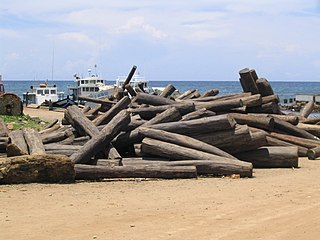
Illegal logging is the harvest, transportation, purchase, or sale of timber in violation of laws. The harvesting procedure itself may be illegal, including using corrupt means to gain access to forests; extraction without permission, or from a protected area; the cutting down of protected species; or the extraction of timber in excess of agreed limits. Illegal logging is a driving force for a number of environmental issues such as deforestation, soil erosion and biodiversity loss which can drive larger-scale environmental crises such as climate change and other forms of environmental degradation.

A bamboo floor is a type of flooring manufactured from the bamboo plant. The majority of today's bamboo flooring products originate in China and other portions of Asia. Moso bamboo is the species most commonly used for flooring.

The Center for International Forestry Research (CIFOR) is a non-profit scientific research organization that conducts research on the use and management of forests with a focus on tropical forests in developing countries. CIFOR, which merged with World Agroforestry on Jan. 1, 2019, is the forestry and agroforestry research center of CGIAR, a network of 15 research centers around the world that focus on agricultural research for sustainable development, working closely with governments and other partners to help develop evidence-based solutions to problems related to sustainable agriculture and natural resource management.

Forestry laws govern activities in designated forest lands, most commonly with respect to forest management and timber harvesting. Forestry laws generally adopt management policies for public forest resources, such as multiple use and sustained yield. Forest management is split between private and public management, with public forests being sovereign property of the State. Forestry laws are now considered an international affair.

Guadua is a Neotropical genus of thorny, clumping bamboo in the grass family, ranging from moderate to very large species.
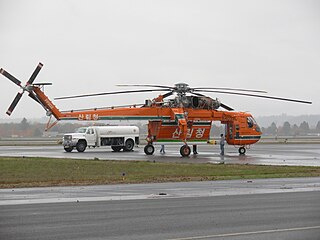
The Korea Forest Service is a central administrative agency under the Ministry of Agriculture, Food and Rural Affairs (MAFR), responsible for protecting and nurturing forests, increasing forest resources, developing forest products, conducting research on forest management and improvement, and is located in Daejeon Government Complex. In the past, during the national forestation campaign from 1973 to 1986, it was temporarily under the Ministry of Home Affairs, but returned to the Ministry of Agriculture, Forestry and Fisheries in 1987. However, as the agency's work was focused solely on maintaining and managing successful national forestation policies, questions were raised about its necessity for a period of time. Currently, the agency has transformed its identity into one that strives to generate continuous income through forest resources.
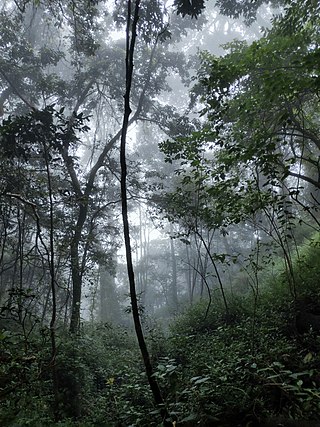
Forest management is a branch of forestry concerned with overall administrative, legal, economic, and social aspects, as well as scientific and technical aspects, such as silviculture, forest protection, and forest regulation. This includes management for timber, aesthetics, recreation, urban values, water, wildlife, inland and nearshore fisheries, wood products, plant genetic resources, and other forest resource values. Management objectives can be for conservation, utilisation, or a mixture of the two. Techniques include timber extraction, planting and replanting of different species, building and maintenance of roads and pathways through forests, and preventing fire.
Sustainable advertising addresses the carbon footprint and other negative environmental and social impacts associated with the production and distribution of advertising materials. A growing number of companies are making a commitment to the reduction of their environmental impact associated with advertising production and distribution.
The following outline is provided as an overview of and guide to forestry:
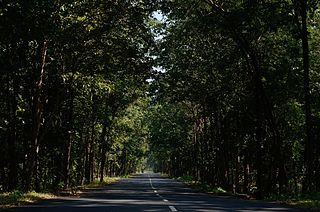
Social forestry is the management and protection of forests and afforestation of barren and deforested lands with the purpose of helping environmental, social and rural development. The term social forestry was first used in 1976 by The National Commission on Agriculture, when the government of India aimed to reduce pressure on forests by planting trees on all unused and fallow lands. It was intended as a democratic approach to forest conservation and usage, maximizing land utilization for multiple purposes.

Bamboo textile is any cloth, yarn or clothing made from bamboo fibres. While bamboo was historically used only for structural elements, such as bustles and the ribs of corsets, in recent years various technologies have been developed that allow bamboo fibre to be used for a wide range of textile and fashion applications.

The Borneo Orangutan Survival (BOS) Foundation is an Indonesian non-profit non-governmental organization founded by Dr. Willie Smits in 1991 and dedicated to the conservation of the endangered Bornean orangutan and its habitat through the involvement of local people. It is audited by an external auditor company and operates under the formal agreement with the Indonesian Ministry of Forestry to conserve and rehabilitate orangutans. The BOS Foundation manages orangutan rescue, rehabilitation and re-introduction programmes in East and Central Kalimantan. With more than 400 orangutans in its care and employing more than 440 people at a 10 sites BOS Foundation is the biggest non-human primate conservation non-governmental organization worldwide. Nyaru Menteng and Samboja Lestari are the BOS Foundation sites that have received most extensive media coverage. Nyaru Menteng, founded by Lone Drøscher Nielsen, has been the subject of a number of TV series, including Orangutan Diary, Orangutan Island and the series Orangutan Jungle School, airing since 2018.

The International Bamboo and Rattan Organization (INBAR) is an independent intergovernmental organization established in 1997 to develop and promote innovative solutions to poverty and environmental sustainability using bamboo and rattan.

Industrial engineering is an engineering profession that is concerned with the optimization of complex processes, systems, or organizations by developing, improving and implementing integrated systems of people, money, knowledge, information and equipment. Industrial engineering is central to manufacturing operations.

Deforestation in Indonesia involves the long-term loss of forests and foliage across much of the country; it has had massive environmental and social impacts. Indonesia is home to some of the most biologically diverse forests in the world and ranks third in number of species behind Brazil and the Democratic Republic of Congo.
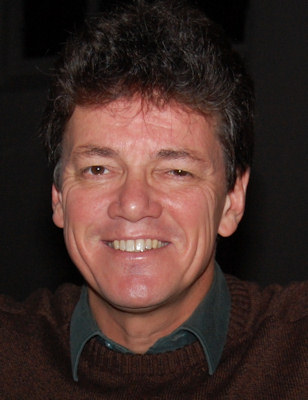
Willie Smits is a trained forester, a microbiologist, conservationist, animal welfare activist, wilderness engineer and social entrepreneur. He has lived in Indonesia since 1985 and is an Indonesian citizen. He is married to Adrienne C. Watson since March 2016.

Samboja Lestari is a Bornean orangutan rescue and rehabilitation centre, tropical rainforest restoration project, sun bear sanctuary, and eco-lodge located in the district of Samboja in Kutai Kartanegara Regency, East Kalimantan, Indonesia, owned and operated by the Borneo Orangutan Survival (BOS) Foundation. According to its founder, Willie Smits, Samboja Lestari uses the principles of People, Planet, Profit, attempting to provide incomes for local people using conservation. It is located about 38 kilometres from Balikpapan.
Environmentally sustainable design is the philosophy of designing physical objects, the built environment, and services to comply with the principles of ecological sustainability and also aimed at improving the health and comfort of occupants in a building. Sustainable design seeks to reduce negative impacts on the environment, the health and well-being of building occupants, thereby improving building performance. The basic objectives of sustainability are to reduce the consumption of non-renewable resources, minimize waste, and create healthy, productive environments.
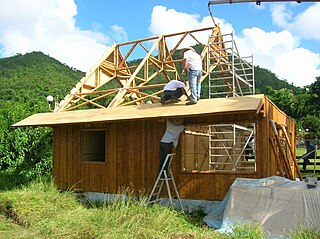
Bamboo construction involves the use of bamboo as a building material for scaffolding, bridges, houses and buildings. Bamboo, like wood, is a natural composite material with a high strength-to-weight ratio useful for structures. Bamboo's strength-to-weight ratio is similar to timber, and its strength is generally similar to a strong softwood or hardwood timber.
Elora Hardy is a Canadian designer, who founded the company IBUKU. She is most well known for designing a community of bamboo homes near Denpasar in Bali. She was born in Canada, grew up in Bali and moved to the United States at the age of 14 to go to boarding school. She then got a degree in fine arts and worked in the fashion industry where she most notably designed prints for Donna Karan. In 2010 Hardy moved back to Bali and founded Ibuku, a design firm that uses bamboo and other natural materials to build homes and structures. Since that time Ibuku has built more than 90 bamboo structures in Southeast Asia and Africa, including the Green School Bali campus. Hardy created a yoga pavilion and riverside cooking classroom at the Four Seasons in Bali, the interior design of Tri restaurant in Hong Kong, furniture for the Como Marketplace in Singapore and tree-house suites at Bambu Indah.
References
- ↑ "Pemanfaatan Bambu Bisa Jadi Solusi Perubahan Iklim". Ministry of Environment and Forestry (Indonesia) (in Indonesian).
- ↑ "Australian-Indonesian bamboo project shines at COP26". Australian Centre for International Agricultural Research.
- ↑ "The DFCD supports Indonesian bamboo company with a grant to build a factory to manufacture bamboo products". DFCD.
- ↑ "Bamboo Pioneers: Linda Garland". World Bamboo.
- ↑ "Bamboo Design Initiative". Rhode Island School of Design.
- ↑ I.V. Ramanuja Rao; Cherla B. Sastry; Brian Belcher; Madhav Karki; Trevor Williams (1996). Bamboo, People and the Environment – Volume 4: Socio-economics and Culture (Report). INBAR.
- ↑ "Bali and the chocolate factory". Financial Times.
- ↑ Environmental Bamboo Foundation (2021). Research, Development and Cost/Benefit Analysis of the Vertical Soak Diffusion Bamboo Preservation Method in a Medium Enterprise Setting (Report). Environmental Bamboo Foundation.
- ↑ "Bamboo Rangers – spearhead sustainable management". The Jakarta Post.
- ↑ "1000 'BAMBOO VILLAGES': CAN INDONESIA'S MODEL INSPIRE OTHER BAMBOO RESOURCE COUNTRIES?". Inbar.